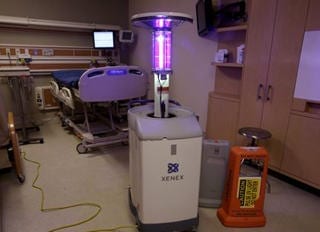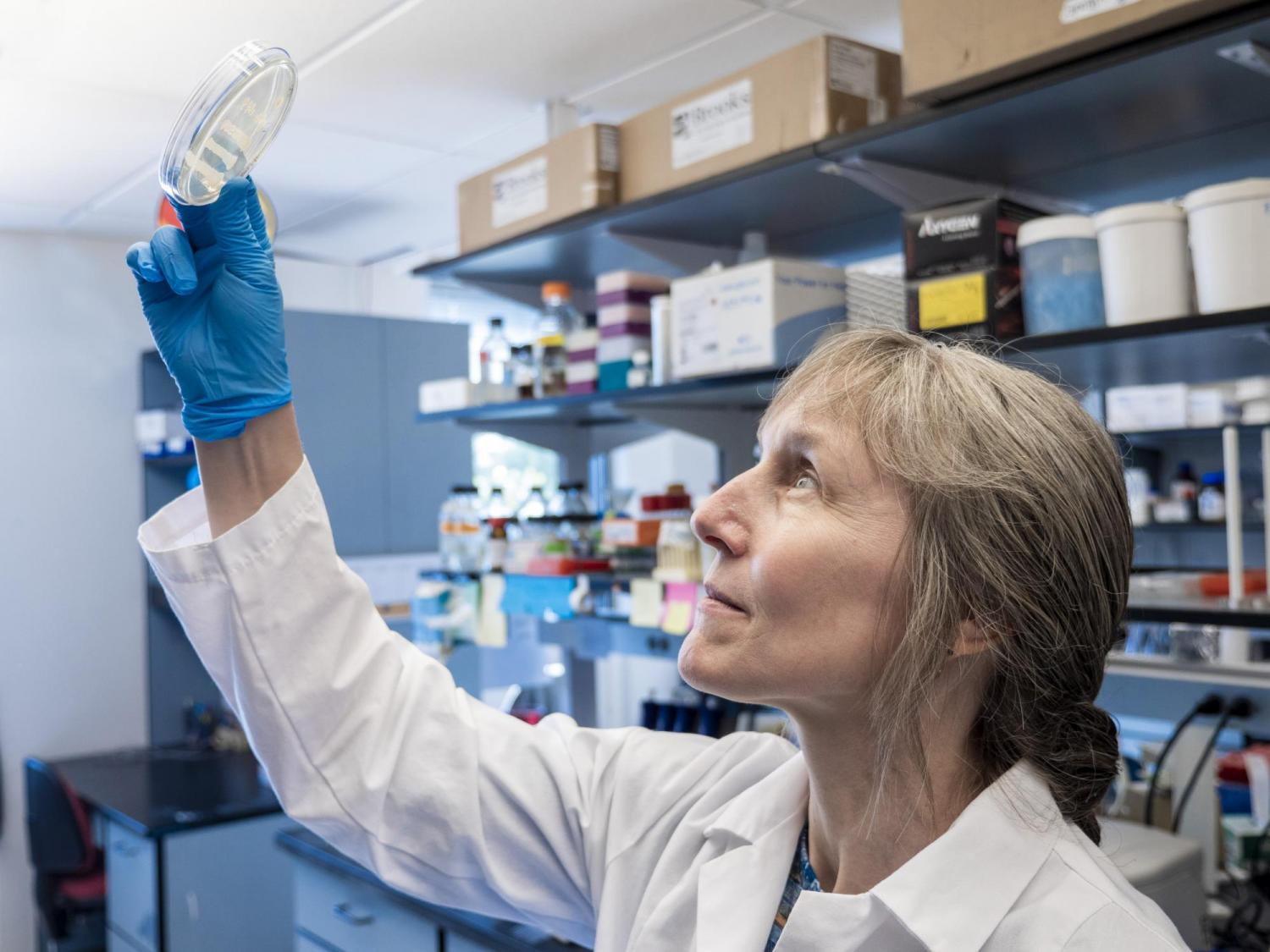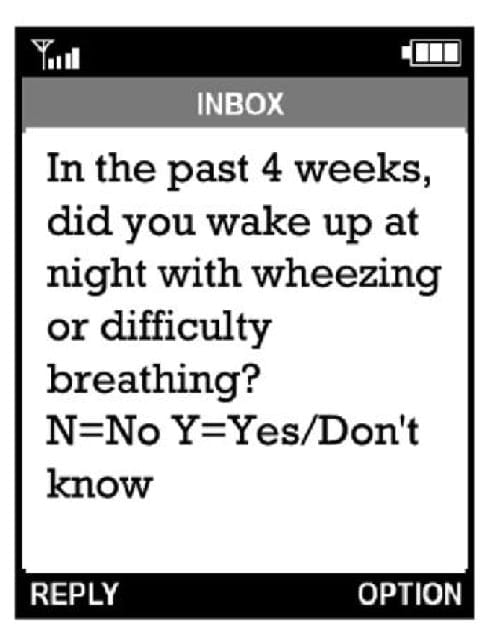
They sweep. They swab. They sterilize. And still the germs persist.
In U.S. hospitals, an estimated 1 in 20 patients pick up infections they didn’t have when they arrived, some caused by dangerous ‘superbugs’ that are hard to treat.
The rise of these superbugs, along with increased pressure from the government and insurers, is driving hospitals to try all sorts of new approaches to stop their spread:
Machines that resemble “Star Wars” robots and emit ultraviolet light or hydrogen peroxide vapors. Germ-resistant copper bed rails, call buttons and IV poles. Antimicrobial linens, curtains and wall paint.
While these products can help get a room clean, their true impact is still debatable. There is no widely-accepted evidence that these inventions have prevented infections or deaths.
Meanwhile, insurers are pushing hospitals to do a better job and the government’s Medicare program has moved to stop paying bills for certain infections caught in the hospital.
“We’re seeing a culture change” in hospitals, said Jennie Mayfield, who tracks infections at Barnes-Jewish Hospital in St. Louis.
Those hospital infections are tied to an estimated 100,000 deaths each year and add as much as $30 billion a year in medical costs, according to the Centers for Disease Control and Prevention. The agency last month sounded an alarm about a “nightmare bacteria” resistant to one class of antibiotics. That kind is still rare but it showed up last year in at least 200 hospitals.
Hospitals started paying attention to infection control in the late 1880s, when mounting evidence showed unsanitary conditions were hurting patients. Hospital hygiene has been a concern ever since, with a renewed emphasis triggered by the emergence a decade ago of a nasty strain of intestinal bug called Clostridium difficile, or C-diff.
The diarrhea-causing C-diff is now linked to 14,000 U.S. deaths annually. That’s been the catalyst for the growing focus on infection control, said Mayfield, who is also president-elect of the Association for Professionals in Infection Control and Epidemiology.
C-diff is easier to treat than some other hospital superbugs, like methicillin-resistant staph, or MRSA, but it’s particularly difficult to clean away. Alcohol-based hand sanitizers don’t work and C-diff can persist on hospital room surfaces for days. The CDC recommends hospital staff clean their hands rigorously with soap and water — or better yet, wear gloves. And rooms should be cleaned intensively with bleach, the CDC says.
Michael Claes developed a bad case of C-diff while he was a kidney patient last fall at New York City’s Lenox Hill Hospital. He and his doctor believe he caught it at the hospital. Claes praised his overall care, but felt the hospital’s room cleaning and infection control was less than perfect.
“I would use the word ‘perfunctory,'” he said.
Lenox Hill spokeswoman Ann Silverman disputed that characterization, noting hospital workers are making efforts that patients often can’t see, like using hand cleansers dispensers in hallways. She ticked off a list of measure used to prevent the spread of germs, ranging from educating patients’ family members to isolation and other protective steps with each C-diff patient.
The hospital’s C-diff infection rate is lower than the state average, she said.
Westchester Medical Center, a 643-bed hospital in the suburbs of New York City has also been hit by cases of C-diff and the other superbugs.
Complicating matters is the fact that larger proportions of hospital patients today are sicker and more susceptible to the ravages of infections, said Dr. Marisa Montecalvo, a contagious diseases specialist at Westchester.
There’s a growing recognition that it’s not only surgical knives and operating rooms that need a thorough cleaning but also spots like bed rails and even television remote controls, she said. Now there’s more attention to making sure “that all the nooks and crannies are clean, and that it’s done in as perfect a manner as can be done,” Montecalvo said.
Enter companies like Xenex Healthcare Services, a San Antonio company that makes a portable, $125,000 machine that’s rolled into rooms to zap C-diff and other bacteria and viruses dead with ultraviolet light. Xenex has sold or leased devices to more than 100 U.S. hospitals, including Westchester Medical Center.
The market niche is expected to grow from $30 million to $80 million in the next three years, according to Frost & Sullivan, a market research firm.
Mark Stibich, Xenex’s chief scientific officer, said client hospitals sometimes call them robots and report improved satisfaction scores from patients who seem impressed that the medical center is trotting out that kind of technology.
At Westchester, workers still clean rooms, but the staff appreciates the high-tech backup, said housekeeping manager Carolyn Bevans.
“We all like it,” she said of the Xenex.
At Cooley Dickinson Hospital, a 140-bed facility in Northampton, Mass., the staff calls their machines Thing One, Thing Two, Thing Three and Thing Four, borrowing from the children’s book “The Cat in the Hat.”
But while the things in the Dr. Seuss tale were house-wrecking imps, Cooley Dickinson officials said the ultraviolet has done a terrific job at cleaning their hospital of the difficult C-diff.
The Latest Bing News on:
Hospitals Combat Superbugs
- Commission approves superbug-busting antibioticon April 22, 2024 at 5:29 am
The European Commission today (22 April) authorised a new antibiotic designed to counter anti-bacterial resistance, one of the biggest health threats the EU is currently facing.
- University Hospital cuts operating loss in 2023on April 18, 2024 at 5:00 pm
Cleveland-based University Hospitals posted an operating loss of $256 million in 2023, an improvement from the $302 million operating loss it posted in 2022, according to its financial report ...
- Fortune/PINC AI 100 Top Hospitals 2024: Teaching Hospitalson April 16, 2024 at 4:01 am
Fortune partnered with PINC AI on the 2024 ranking of the 100 Top Hospitals in the U.S. The top 40 teaching hospitals are presented below, broken into two categories: the 15 Top Major Teaching ...
- Antibiotic-resistant ‘superbugs’ are being passed from pets to humanson April 13, 2024 at 6:42 am
Study finds pets in UK and Portugal carry and potentially transmit the same antibiotic-resistant bacteria as their owners.
- Some hospitals are changing their response when babies are born exposed to drugson April 11, 2024 at 3:47 am
Change is afoot at many levels. Health systems like the Yale New Haven Children’s Hospital and Boston Medical Center have implemented new drug testing and reporting protocols like those Mass ...
- Top superbugson April 9, 2024 at 5:00 pm
They are colloquially known as superbugs. Around 700,000 people die of resistant ... It normally is only seen in people in hospitals or with weakened immune systems – and commonly affects those with ...
- Hospital infections kill hundreds of thousands in sub-Saharan Africa, research showson April 9, 2024 at 7:49 am
Infections acquired in hospitals are costing Sub-Saharan Africa ... WaterAid warned in a statement. “Superbugs pay little to no respect to country borders,” said Oyuela.
- CMS Invites Hospitals To Raise Prices And Buy Physician Practiceson March 31, 2024 at 10:21 am
I am a professor of accounting and health policy at Johns Hopkins. Mounting hospital bills, crushing medical debt, ballooning insurance premiums… While we are wrestling with these widespread ...
- For-profit companies open psychiatric hospitals in areas clamoring for careon March 30, 2024 at 5:00 am
Grinnell, Iowa — A for-profit company has proposed turning a boarded-up former nursing home here into a psychiatric hospital, joining a national trend toward having such hospitals owned by ...
- Patients fear hospital superbugson March 27, 2024 at 5:01 pm
Health Secretary John Reid has told managers to combat the problem, with all hospitals in England having to appoint an infection 'czar'.
The Latest Google Headlines on:
Hospitals Combat Superbugs
[google_news title=”” keyword=”Hospitals Combat Superbugs” num_posts=”10″ blurb_length=”0″ show_thumb=”left”]
The Latest Bing News on:
Disinfecting Robots
- Best cat litters to fit every cat (and human) preferenceon April 26, 2024 at 12:31 pm
The best cat litters will fit your budget, help neutralize odors and aren’t easily trackable. These options will help you find one you and your cat will like.
- UV-C Disinfection Robot Market CAGR of 32% Importance of Net Promoter Score Measuring and Improving Customer Loyaltyon April 25, 2024 at 8:28 pm
The robots developed with UV-C light, are used as a part of the consistent cleaning cycle, which results in preventing and reducing the spread of communicable diseases caused by viruses, bacteria, and ...
- Volkswagen Rethinks EV Strategy in China With Breathtaking ID. Code Concepton April 25, 2024 at 12:34 am
The Volkswagen ID. Code concept marks an overhaul of the brand's strategy in China, with breathtaking design and cool technologies tailored for the local market ...
- 7 Eco-Friendly Technologies for a Sustainable Futureon April 24, 2024 at 10:43 am
Building an eco-friendly environment to combat carbon emissions. From cloud computing to electric vehicles, these technologies conserve natural habitats.
- Albuquerque restaurant using robots to improve food safetyon April 22, 2024 at 7:07 am
A popular restaurant chain is finding new ways to ensure food safety with robots. “Build with Robots” launched its first food service partnership with ...
- Morris Miller, CEO of Xenex, wants to invade U.S. hospitals with germ-killing robotson April 18, 2024 at 2:01 am
Morris Miller, CEO of Xenex Disinfection Services Inc., wants to invade U.S. hospitals with the company’s germ-killing robots.
- At Chinese trade fair, exporters fear goods are 'as cheap as cabbage'on April 17, 2024 at 4:23 am
Wu Huazhan's Chinese television factory used to impose minimum orders to manage production efficiently. Times are now so bleak, it will take any order.
- How robotics-as-a-service is transforming guest experienceson April 16, 2024 at 7:29 pm
While robots may not be fully integrated into hotel operations just yet, RaaS offers a compelling solution for hotels to elevate guest experiences and optimise operations.
- Would You Trust A Robot To Save Your Life? Why Robotics Thrive In Healthcareon April 16, 2024 at 9:59 am
Spanish doctors performed robotic heart surgeries on teenagers in Barcelona. Learn how robotics in healthcare improves patient care and outcomes.
- How Stories About Human-Robot Relationships Push Our Buttonson April 15, 2024 at 3:00 am
Two new novels, “Annie Bot” and “Loneliness & Company,” reflect anxieties about A.I. coming for our hearts as well as for our jobs.
The Latest Google Headlines on:
Disinfecting Robots
[google_news title=”” keyword=”Disinfecting Robots” num_posts=”10″ blurb_length=”0″ show_thumb=”left”]










